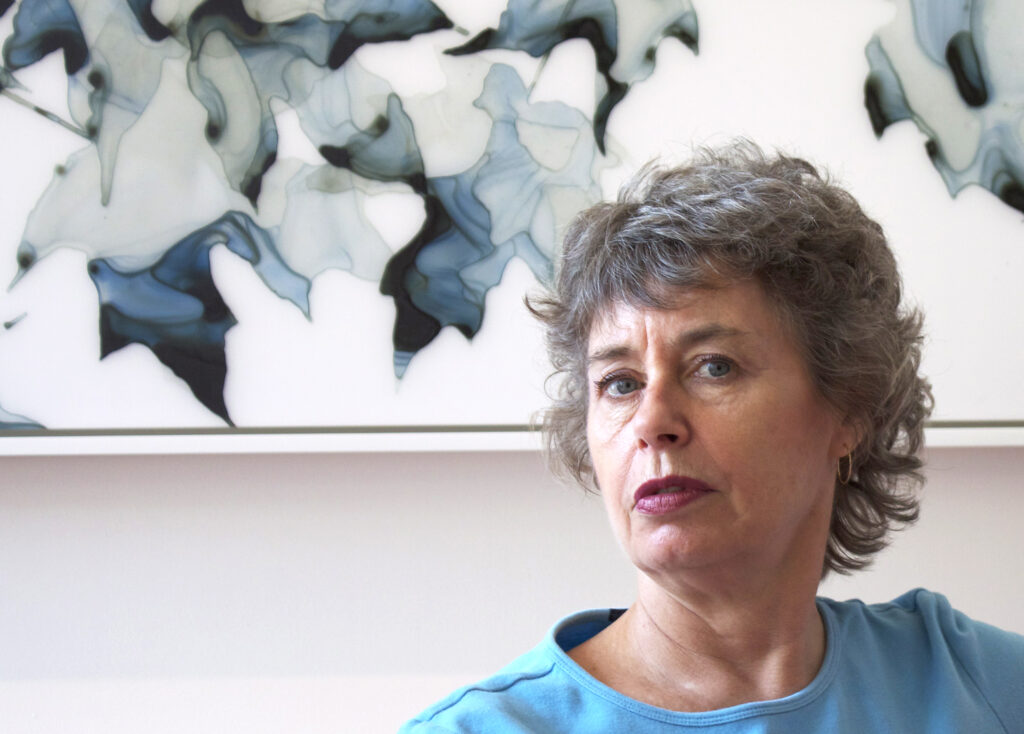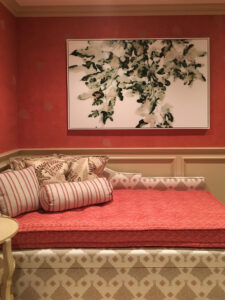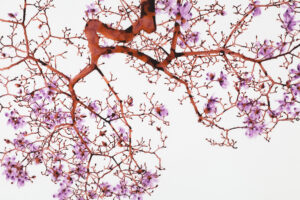Jackie Battenfield is known for her luminous paintings and prints of natural forces. Her works explore her fascination with the most abstract qualities of landscape—most recently the natural unfolding and leafing of a tree branch. She sees the painting process itself as akin to an intimate meditation on landscape.
Curator Gabriel de Guzman wrote in his recent essay, “[Battenfield’s] mastery of watery acrylic paint on Mylar is reflected in the luminous depictions of blossoms and leaves against the open sky. Through a contemplative and meticulous process, she finds a natural correlation between a sinuous, branching tree limb and the diffusion of pigments in fluid.” . . . “A feeling of quiet wonder in the presence of natural phenomena infuses Battenfield’s work.”
Recent solo and 2-person exhibitions include Chasing the Sky, Chicago Art Source (2018); Branched, Addison/Ripley Fine Art, Washington, DC (2017); Mirage, Kenise Barnes Fine Art, Larchmont, New York (2015); and Another Garden Wave Hill, Bronx, New York (2014). In 2018, Tree Canopy, four mural-sized paintings commissioned by The MTA Arts & Design program in New York City were permanently installed in the Avenue P subway station in Brooklyn.
She is the recipient of a Pollock-Krasner Award, the David Alfaro Siqueiros Award, the Arts & Architecture Alumni Award from Pennsylvania State University, and the U.S. Fulbright Specialist Program. Her work is represented in more than 500 collections worldwide including the New York Public Library, NY; The Zimmerli Art Museum, Montclair Art Museum, NJ; Palmer Museum, University Park, PA; University Museum of Art, Tucson, AZ; Joel and Lila Harnett Museum of Art; the Progressive Corporation; and the United States Embassy Collections, Brazil, Cambodia, Croatia, Jamaica, and Peru.
For over twenty years, Jackie has made a living from her art and is a popular motivational speaker on the challenges of sustaining a successful career in the visual arts. She is the author of The Artist’s Guide: How to Make a Living Doing What You Love, Da Capo Press, 2009 and teaches in the MFA Program at Columbia University, School of the Arts in New York.
How did you find yourself in the arts?
It found me at the beginning of my junior year of college with a comment from my boyfriend, “Gee Jackie, you are so creative, have you ever thought about being an artist?” Eureka! What followed was two blissful years of studio and art history classes. I never looked back.
Who has been a big influence to you in your career?
I love reading artist biographies which provide fascinating insights into how artists manage art, career, and life. I admire Andy Warhol who effortlessly integrated his art with a shrewd business sense. Creatively — Alex Katz, Morris Louis, Matisse, Japanese Zen Buddhist painting, and Chinese landscapes.
When you hit a creative block, how do you move forward?
I go to museums and galleries, visit artists’ studios, and most importantly, I still show up every day in my studio. I trust the creative process will eventually lead me out of the murkiness and back into some light.
Did you ever think you would be an art career mentor at places like Bronx Museum’s AIM Program and Columbia University?
It wasn’t something I planned to do, but when offered the opportunity, it felt like a perfect fit.
Furthermore, did you expect that you’d end up writing one of the definitive books on the topic?
No! I was nagged by others for a decade to “write it all down.” The idea slowly gained traction until one day I knew it was the right time for me to do it.
In addition to your book, could you suggest some resources for practicing artists to better bolster their careers?
There are many great online resources. Here are two: Freelancers Union Blog and Etsy Seller Handbook. Pick through these blogs to find solid information on all aspects of a creative business: marketing, legal issues, getting paid, building community, just to name a few. To keep abreast of what’s happening in the art world locally and internationally, I also subscribe to artnet News, The Art Newspaper, as well as local blogs and newsletters.
If there is only one point you want for all artists to take away from your career mentoring, what might that be?
It’s important to make the best work you can but equally necessary, to realize a studio artist is also running a small business. Take care of both.
What message do you hope your body of work communicates?
With so much strife and ugliness in the world, I want my paintings to help you take a moment to stop and slowly contemplate something beautiful. The world can wait.
What has been an important lesson you have learned during your career?
Don’t take rejection or success personally.
Finally, what advice might you give to your younger self?
An art career is like a roller-coaster ride, all ups and downs. Hang on tight and enjoy the ride.
How do you define success?
Having the time, space, and resources to make what I love.












